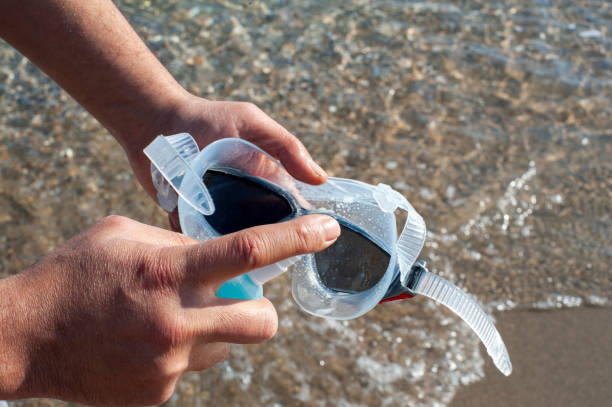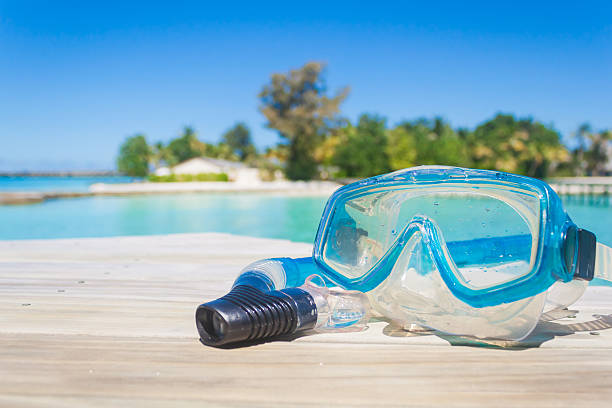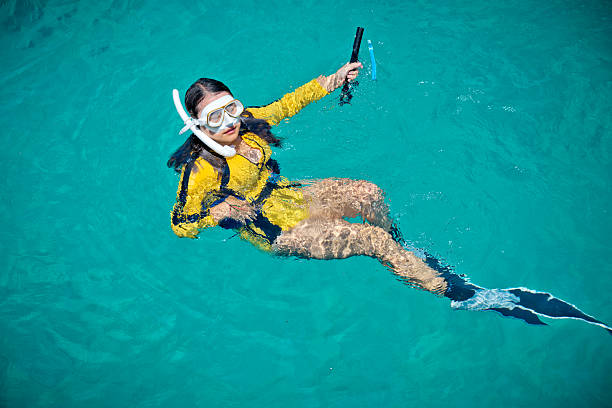수상 활동은 오랫동안 모험가와 자연 애호가 모두의 관심을 사로잡아 왔습니다. 깊은 바닷속으로 뛰어들고, 신비로운 수중 세계를 탐험하고, 놀라운 해양 생물을 만나는 매력은 스쿠버 다이빙과 스노클링의 인기를 더욱 높였습니다. 이 글에서는 이러한 활동의 매혹적인 영역을 깊이 있게 살펴보고, 각 활동의 정의, 사용 장비, 고유한 이점, 그리고 차이점을 살펴봅니다. 더 깊은 곳으로 다이빙하는 것을 좋아하든, 수면에서 해양 생물을 관찰하는 것을 선호하든, 이 수중 모험에 함께해 보세요.
스쿠버 다이빙이란?

스쿠버 다이빙은 Self-Contained Underwater Breathing Apparatus의 약자로 개인이 바다 깊은 곳으로 파고들다인간의 탐험에서 일반적으로 가려져 있는 영역을 발견하는 것입니다. 수중 호흡과 기동성을 향상시키도록 설계된 특수 장비를 사용하는 것이 포함됩니다. 다이빙 마스크, 스노클, 핀, 스쿠버 탱크, 레귤레이터, 부력 조절 장치(BCD), 다이브 컴퓨터, 그리고 잠수복이나 건식 슈트를 갖춘 스쿠버 다이버는 더 깊은 곳까지 잠수하여 종종 사람의 손길이 닿지 않은 세상을 탐험할 수 있습니다.
더 깊이 잠수하는 스릴
스쿠버 다이빙의 가장 큰 매력 중 하나는 모험가들이 수중 세계로 더 깊이 들어갈 수 있도록 해 준다는 것입니다. 다이버들은 더 깊이 잠수할수록 증가하는 압력과 끊임없이 변화하는 환경이라는 매혹적인 현상을 경험하게 됩니다. 무중력 상태의 감각과 미지의 영역을 탐험하는 흥분은 비교할 수 없는 모험심과 스릴을 선사합니다.
스쿠버 다이빙의 이점
스쿠버 다이빙은 아드레날린이 솟구치는 순간 외에도 수많은 이점을 제공합니다. 다이버들은 수중 세계를 탐험하면서 다채로운 해양 생물들을 만나게 되는데, 각각의 생물은 더욱 황홀해집니다. 생동감 넘치는 산호초와 반짝이는 물고기 떼를 만나고, 위풍당당한 바다거북과 함께 수영하는 것까지, 스쿠버 다이빙은 진정으로 비할 데 없는 자연과의 친밀한 교감을 만들어냅니다. 더 나아가, 다이버들은 고대 난파선의 비밀을 파헤치고, 바닷속에 조용히 잠들어 있는 역사를 목격할 수도 있습니다.
스노클링이란?

선호하는 사람들을 위해 수면에서 해양 생물 관찰스노클링은 접근 가능한 대안을 제공합니다. 스노클링에는 스노클 마스크, 스노클링 핀, 스노클, 그리고 더 차가운 물에서는 잠수복. 스쿠버 다이빙과 달리 스노클링은 다음과 같이 제한됩니다. 수면 근처의 얕은 물 탐험스쿠버 다이빙만큼 깊이가 깊지 않고 장비도 부족하지만, 스노클링은 애호가들에게 수중 세계를 들여다볼 수 있는 매혹적인 창을 제공합니다.
한계와 얕은 물 탐험
스노클링은 수중 환경을 만끽할 수 있게 해 주지만, 그 자체로 한계가 있습니다. 스노클을 통해 수면 호흡을 해야 하기 때문에, 얕은 물에서만 탐험이 가능하며, 숨을 쉬기 위해 수면 위로 쉽게 올라올 수 있다는 한계가 있습니다. 하지만 이러한 한계가 스노클링의 매력을 약화시키는 것은 아닙니다. 숨 막힐 듯 아름다운 해양 생물, 매혹적인 산호초, 그리고 생동감 넘치는 생태계가 여전히 우리를 기다리고 있기 때문입니다.
스노클링의 이점
스노클링은 남녀노소 누구나 즐길 수 있는 수상 스포츠의 세계로의 쉬운 입문입니다. 스노클링을 통해 열광적인 사람들은 자연 서식지에서 해양 생물을 관찰하고, 다채로운 산호초 위를 편안하게 미끄러지듯 나아가 그 아래에서 헤엄치는 다채로운 해양 생물들을 감상할 수 있습니다. 스노클링은 경이로운 광경을 선사할 뿐만 아니라, 바다의 경이로움에 대한 감사와 평온함을 느끼게 해 줍니다.
스쿠버 다이빙과 스노클링의 차이점
| 스쿠버 다이빙 | 스노클링 | |
| 필요한 장비 | 다이빙 마스크, 레귤레이터, BCD, 다이빙 슈트, 핀, 압축 공기 탱크 | 다이빙 마스크, 스노클, 핀 |
| 깊이 제한 | 인증 수준 및 경험에 따라 최대 130피트까지 | 표면 또는 얕은 깊이(일반적으로 3~20피트)로 제한됨 |
| 호흡 | 자급식 수중 호흡 장치(스쿠버) | 스노클을 통한 수면 호흡 |
| 필요한 교육 | 장비의 안전과 이해를 위한 인증 과정 및 지속적인 교육 | 정식적인 훈련은 필요하지 않지만 기본 수영 기술은 권장됩니다. |
| 비용 | 장비 및 인증 과정의 초기 비용이 더 높음 | 비용이 저렴하며 주로 기본 스노클링 장비 구매에 국한됨 |
스쿠버 다이빙과 스노클링은 둘 다 수중 세계를 엿볼 수 있게 해주지만, 깊이 제한, 호흡 기술, 장비 종류, 인증 요건 등에서 상당한 차이가 있습니다.
수심 제한 및 수중 경험
스쿠버 다이빙과 스노클링의 가장 뚜렷한 차이점 중 하나는 깊이에 대한 제한입니다.
스노클링 바다 표면 근처의 얕은 물에만 국한되어 있어 개인이 바다의 생생한 표면을 탐험할 수 있습니다.
스쿠버 다이빙 열광적인 팬들은 더 깊은 곳으로 모험을 떠나 미지의 영역을 탐험하고 심해의 비밀을 푸는 스릴을 경험할 수 있습니다.
호흡 기법
스쿠버 다이빙과 스노클링에 사용되는 호흡 기술도 근본적으로 다릅니다.
스노클러들 스노클 튜브에 의지하여 숨을 쉬며, 얼굴은 물속에 반쯤 잠긴 상태를 유지합니다. 이렇게 하면 공기를 마시기 위해 수면으로 다시 올라올 필요 없이 해양 생물을 계속 관찰할 수 있습니다.
스쿠버 다이버 압축 공기 탱크에 연결된 조절기를 활용하여 수면에 관계없이 수중에서 자유롭게 호흡할 수 있습니다.
장비 변형

스쿠버 다이빙과 스노클링은 장비에 따라 뚜렷한 차이가 있습니다.
스쿠버 다이버 다이빙 마스크, 스노클, 핀, 스쿠버 탱크, 레귤레이터, 부력 조절 장치(BCD), 다이브 컴퓨터, 습식 슈트 또는 건식 슈트 등 다양한 장비에 의존합니다. 이러한 각 장비는 다이버의 수중 안전, 편안함, 그리고 기동성을 향상시키도록 설계되었습니다.
반면에, 스노클링 마스크, 스노클, 핀으로 구성된 간단한 장비가 필요하며, 차가운 물에서는 잠수복이 필요합니다.
비용 차이
기술적인 차이 외에도 스쿠버 다이빙과 스노클링은 비용 면에서도 차이가 있습니다.
스쿠버 다이빙 전문 장비와 훈련에 상당한 투자가 필요하기 때문에 수업과 장비 대여 비용이 더 비쌀 수 있습니다.
반면에, 스노클링 장비 비교적 저렴하고 접근성이 좋아서 수상 스포츠를 처음 접하는 사람들에게 비용 효율적인 선택이 될 수 있습니다.
스쿠버 다이빙 인증 요건
최소한의 훈련만 필요하고 누구나 쉽게 접근할 수 있는 스노클링과 달리, 스쿠버 다이빙은 자격증 취득이 필수입니다. 더 깊은 수심에서 다이빙하고 복잡한 장비를 사용하는 데 따르는 위험 때문에, 스쿠버 다이빙을 원하는 사람은 안전과 역량을 보장하기 위해 자격증 과정을 이수해야 합니다. 스쿠버 다이빙 자격증 취득에는 이론 및 실습 교육뿐 아니라, 다이버가 잠재적 위험과 비상 상황에 대처할 수 있는지 확인하는 평가도 포함됩니다.
스쿠버 다이빙은 안전한가요?

스쿠버 다이빙은 비교할 수 없는 관점과 스릴 넘치는 경험을 선사하지만, 이와 관련된 안전 문제를 해결하는 것이 매우 중요합니다. 통계에 따르면 숙련된 사람이라도 스쿠버 다이빙 사고가 발생할 수 있습니다. 사고의 주요 원인으로는 부적절한 장비 사용, 계획 미비, 기술 부족, 다이빙 환경에 대한 인식 부족 등이 있습니다. 이러한 위험을 줄이기 위해 여러 안전 조치와 규정이 마련되어 있습니다.
스쿠버 다이버의 안전을 보장하기 위해 다이빙 기록 제출 및 정기 건강 검진을 포함한 다양한 조치가 마련되어 있습니다. 다이빙 로그다이버는 이를 통해 자신의 경험을 추적하고, 다이빙 기록을 유지하고, 상승 속도, 깊이, 바닥 잠수 시간을 모니터링할 수 있습니다. 건강 검진 다이빙 중 위험을 초래할 수 있는 기존 질환을 파악하는 데 필수적입니다. 또한, 다이빙 보험은 사고나 응급 의료 상황 발생 시 재정적 보호를 제공할 수 있습니다.
스쿠버 다이빙 및 스노클링 목적지

스쿠버 다이빙과 스노클링의 매력은 액티비티 자체뿐만 아니라, 숨 막힐 듯 아름다운 곳으로 이어지는 여행지에서도 찾을 수 있습니다. 넋을 잃을 만큼 아름다운 산호초부터 수중 동굴, 고대 난파선까지, 세상은 이러한 액티비티를 위한 최고의 장소들로 가득합니다.
전 세계 최고의 스쿠버 다이빙 명소
호주의 그레이트 배리어 리프 가장 상징적인 스쿠버 다이빙 명소 중 하나로, 다채로운 해양 생물이 가득한 매혹적인 생태계를 자랑합니다. 벨리즈의 블루홀이 당신을 부릅니다 깊고 매혹적인 싱크홀이 있는 다이버 몰디브 수중 탐험가들에게는 천국과도 같은 곳으로, 수정처럼 맑은 바닷물과 풍부한 해양 생물 다양성을 자랑합니다.
초보자를 위한 최고의 스노클링 장소
스노클링을 처음 접하는 분들을 위해 카리브해 섬들 이상적인 여행지를 제공합니다. 따뜻한 청록색 바닷물, 무성한 산호 정원, 그리고 풍부한 해양 생물을 자랑하는 이 섬들은 초현실적인 스노클링 경험을 선사합니다. 이집트의 홍해 그리고 하와이 해변 고요하고 맑은 바닷물로 유명하며, 초보자가 스노클링의 경이로움에 푹 빠질 수 있는 이상적인 장소입니다.
스쿠버 다이빙 또는 스노클링을 시작하는 방법

스쿠버 다이빙이나 스노클링의 매력에 사로잡혔다면, 생각보다 쉽게 시작할 수 있습니다. 수중 여행을 시작하기 위한 몇 가지 필수 단계를 소개합니다.
스쿠버 다이빙을 시작하는 방법
- 평판 좋은 다이빙 센터 찾기: 공인 스쿠버 다이빙 코스를 제공하는 평판 좋은 다이빙 센터를 조사하고 선택하세요. 경험이 풍부한 강사와 긍정적인 후기를 보유한 센터를 찾아보세요.
- 올바른 스쿠버 다이빙 코스 선택: 다양한 스쿠버 다이빙 코스가 있으며, 실력에 따라 선택하실 수 있습니다. 본인의 필요에 맞는 코스를 선택하여 종합적인 교육과 자격증을 취득하세요.
- 장비 구매 또는 임대: 다이빙에 대한 여러분의 의지에 따라 스쿠버 다이빙 장비를 구매하거나 대여하실 수 있습니다. 장비가 몸에 잘 맞고 안전 기준을 충족하는지 확인하세요.
스노클링을 시작하는 방법
- 적합한 스노클링 장소 찾기: 근처 또는 원하는 여행지에서 적합한 스노클링 장소를 조사하고 찾아보세요. 풍부한 해양 생물과 선명한 산호초가 있는 잔잔한 바닷물을 찾아보세요.
- 스노클링 장비 대여 또는 구매: 스노클링이 처음이라면 장비 대여를 통해 관심 수준을 파악하는 것이 좋습니다. 하지만 정기적으로 스노클링을 할 계획이라면 장비에 투자하는 것이 좋습니다.
- 기본 스노클링 기술 배우기: 마스크 물 빼기, 효율적인 핀 사용, 스노클을 통한 올바른 호흡 등 기본적인 기술을 익히세요. 초보자도 쉽게 참여할 수 있는 스노클링 투어에 참여하거나 레슨을 받으면 실력 향상에 도움이 될 수 있습니다.
결론
결론적으로, 스쿠버 다이빙과 스노클링은 수중 세계를 탐험하고 자연의 아름다움에 푹 빠질 수 있는 특별한 기회를 제공합니다. 광활한 바닷속 깊은 곳으로 모험을 떠나든, 수면 위에서 경이로운 풍경을 감상하든, 두 활동 모두 최고의 경험을 선사합니다. 고대 난파선을 발견하고 장엄한 바다 생물을 만나는 것부터 산호초의 선명한 색을 만끽하는 것까지, 수중 세계의 매혹적인 세계가 여러분을 기다립니다. 초보자든 베테랑 모험가든, 오리발을 착용하고 미지의 세계로 나아가 자연에 대한 사랑을 키우고 바다의 마법을 밝혀줄 여정을 시작해 보세요.



